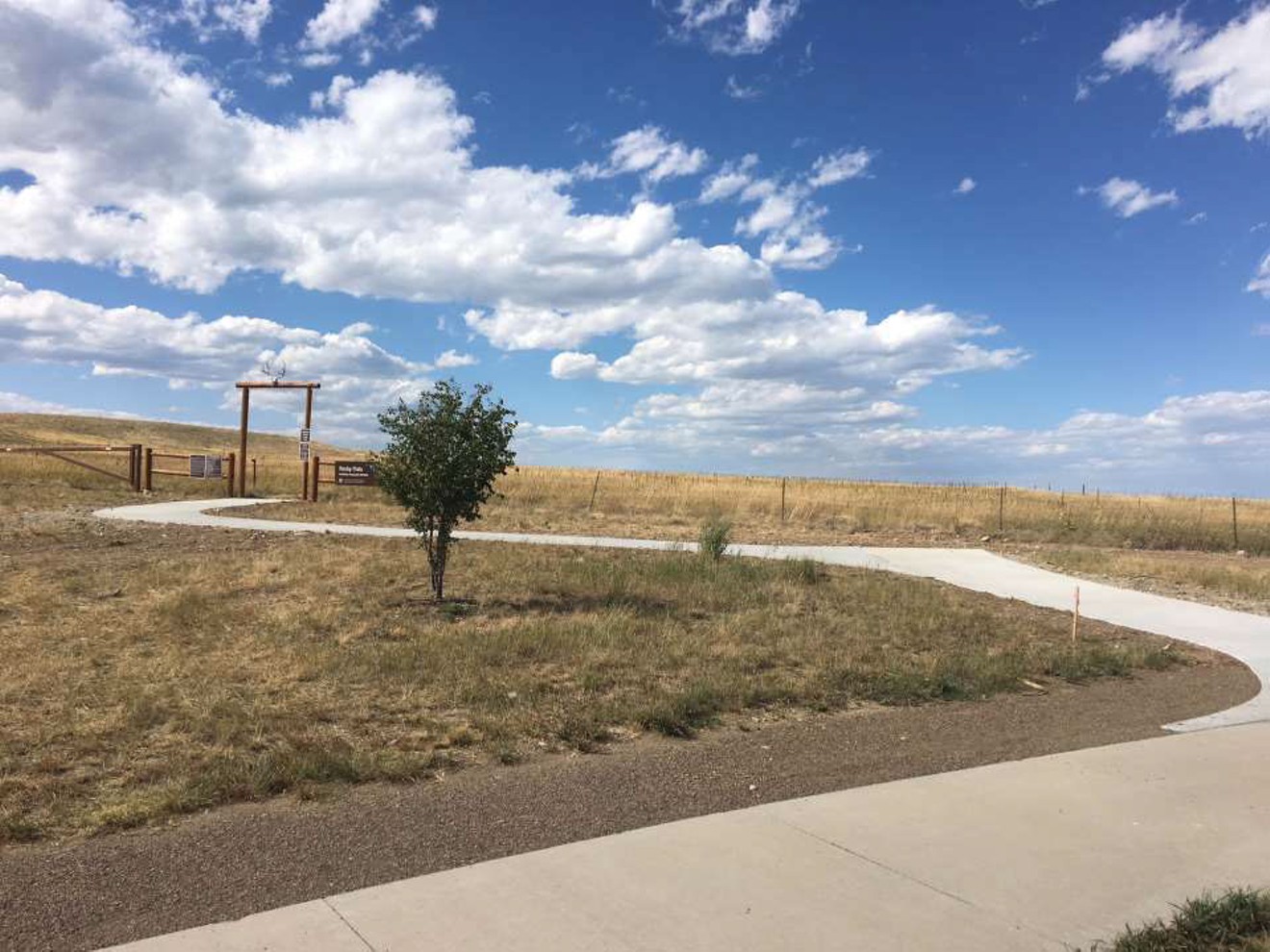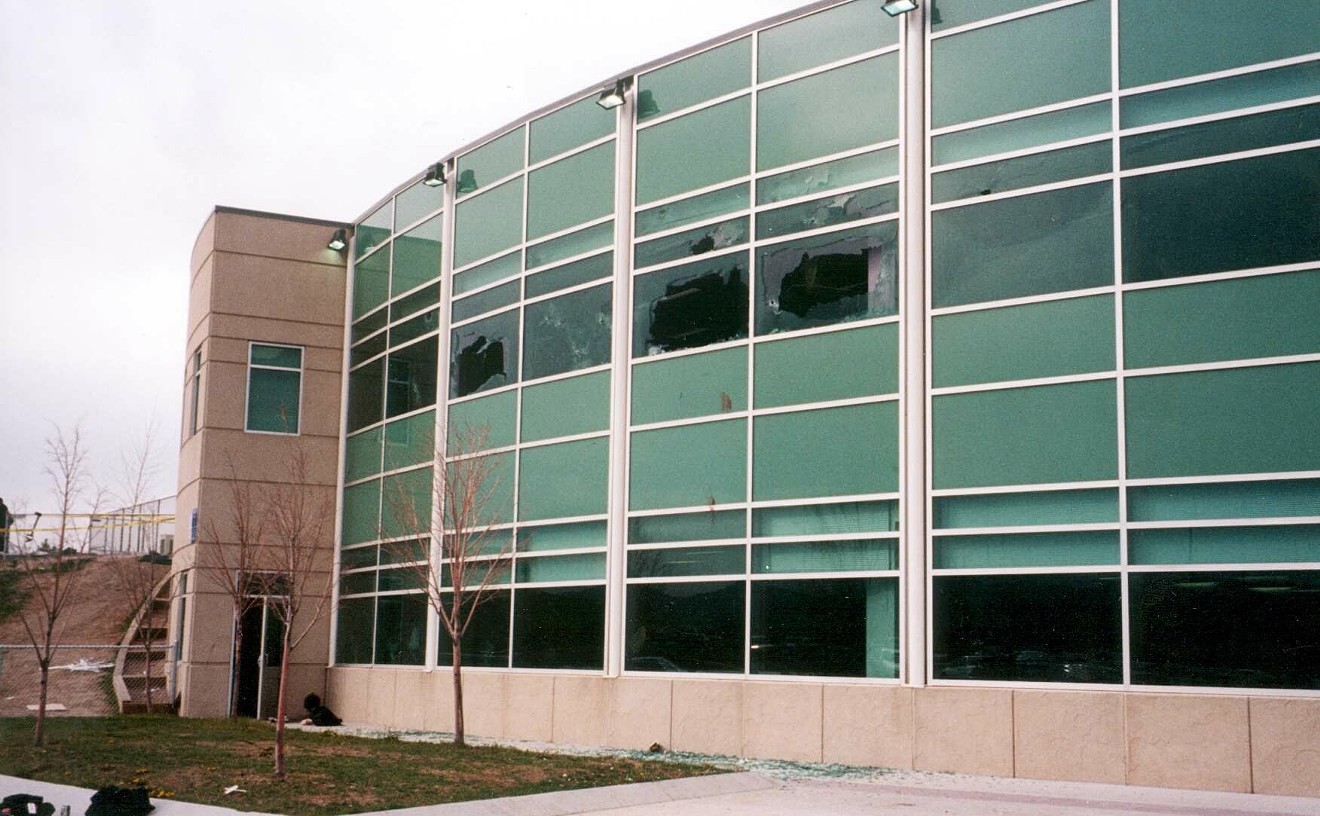“What happened here?”
Under an agreement signed in 2007, those three words were supposed to appear at the top of the signs erected at all trailheads and other public-access points to the Rocky Flats National Wildlife Refuge.
But ahead of the refuge’s scheduled debut on September 15, those words have been replaced with a chirpy “Welcome to Rocky Flats National Wildlife Refuge, home to over 239 species of wildlife and over 630 species of plants.” And that’s not counting the most notorious plant of all, the Rocky Flats Nuclear Weapons Plant, which once manufactured all the plutonium triggers for America’s nuclear arsenal on this stunning, windswept expanse of xeric tallgrass prairie, with the foothills as a dramatic backdrop and downtown Denver off in the distance, sixteen miles away. Downwind.
What happened here?
The real story of Rocky Flats is too sprawling to fit on a single sign. The record fills dozens of boxes of top-secret documents that sit in a federal courthouse, still off limits to the public. It’s locked away in the memories of Colorado’s first-ever special grand jury, empaneled thirty years ago to consider evidence seized in the spectacular raid of the Rocky Flats Nuclear Weapons Plant by seventy FBI and EPA agents at dawn on June 6, 1989 — the first-ever raid by one government agency of another, the Department of Energy. By the time the grand jurors were done considering the evidence, they wanted to indict eight individuals, from both the DOE and Rockwell International, which ran the plant for the government, for alleged environmental crimes at the plant; in a special report, the jurors called it an “ongoing criminal enterprise.”
But instead of charging those individuals, in March 1992 the Department of Justice cut a deal with Rockwell, fining the company $18.5 million — less than the annual bonus Rockwell was given on top of its fee for operating the plant — and indemnifying it from future prosecution. (Rockwell’s contract made sure the feds covered its legal fees, too — not just in this case, but in a class action case filed by nearby property owners soon after the raid.) Meanwhile, the grand jurors were threatened with contempt-of-court charges if they ever talked about what had happened behind closed doors.
The grand jury foreman, Wes McKinley, was so outraged by the threat that he ran for Congress, hoping to employ a congressional loophole to talk about the grand jury’s investigation. He lost that race but won a seat in the Colorado Legislature, where he fought for honest signage at Rocky Flats. That legislation failed, but he wound up co-writing a book, The Ambushed Grand Jury, that detailed both physical contamination at Rocky Flats and dirty dealings at the Department of Justice.
The story of Rocky Flats goes back much further than that, though. We’ll skip the chapters the feds like to push these days — on the animals that once roamed the land, the Native American tribes that hunted here, the ranchers who tried to eke a living out of this open plateau — and pick it up during the Cold War, when the Atomic Energy Commission launched “Project Apple” and started searching the country (not too close to the coasts) for a place to put a facility that would manufacture plutonium triggers for atomic bombs. The AEC didn’t supply that much information to the municipalities eager for a federal plum, though: It touted jobs and talked about patriotic duty, and metro Denver was ready to step up. “Good News Today,” the Rocky Mountain News applauded in a front-page headline when the AEC announced it was putting the plant at Rocky Flats. After that, the AEC and its successor, the DOE, didn’t say much about Project Apple, certainly not after things started to go bad, with two fires that spewed plutonium into the sky. Even so, protesters regularly gathered at the gate, first to protest atomic weapons, then to warn of environmental hazards. In November 1988, several went on trial in Jefferson County, including Daniel Ellsberg, of Pentagon Papers fame. While calling the dangers at Rocky Flats “real and continuing,” the judge refused to let the defendants use the choice-of-evils defense, and they were convicted of trespassing.
Then came the raid. Jon Lipsky was the affiant on the search warrant; then a 35-year-old agent in the FBI’s Denver office, he’d been investigating the plant for more than two years, ever since he’d read an internal DOE document describing major problems at the facility. There were charges of missing plutonium (since confirmed), leaks in the glove boxes used by workers handling the deadly element (ditto), and faulty storage of hazardous waste (including the infamous pondcrete — hardened wastes that were supposed to survive the elements but were soon seeping into the ground).
While the grand jury did its work (until it was told to halt), the plant stopped production and was ultimately named a Superfund site. Initially, the feds estimated that cleanup of the 6,000-plus-acre site would take decades and cost $35 million. But after a certain level of funding was guaranteed in 1999, the DOE said it could finish the job by December 2006. Contractor Kaiser-Hill beat that date, finishing in October 2005 for $7.5 billion and still meeting all the requirements of the Rocky Flats Cleanup Agreement.
The property was declared clean — as clean as it was going to get, anyway. Here’s how the new sign describes the process: “Beginning in 1992, many of the same Cold War veterans who had built weapons components at the Plant assisted with an unprecedented and enormously complex Comprehensive Response, Compensation, and Liability Act (‘Superfund’) cleanup project to investigate and remediate the site. Thousands of soil, water, air and sediment samples were collected and analyzed by laboratories. … Based on the results of the investigation, it was determined that no remediation was required on Refuge lands.”
Those are the 5,237 acres that were transferred in 2007 to the U.S. Fish and Wildlife Service, which was charged with resurrecting the area as a refuge, much like the former Rocky Mountain Arsenal northeast of Denver. Another 1,309 acres in the Central Operable Unit, where 800 structures once stood and over 10,000 people worked every day, remain the property of the DOE Legacy Management Staff, off limits forever...or at least until everyone forgets what happened here. The sign already glosses over the past at the COU: “Please do not enter this area as groundwater treatment systems are currently operating and two closed landfills are being maintained,” it says of the COU. And never mind the structures belowground, deemed so contaminated that they were easier to bury than break up and cart away.
What really happened here?
That’s what attorney Randall Weiner would like to know. On May 1, on behalf of five citizen groups, his office filed suit against the U.S. government for failing to comply with the National Environmental Policy ACT (NEPA) in planning to build public trails and a visitor center at the former plant; the suit argues that Fish and Wildlife had not completed the required analysis of environmental risks and policy options before announcing plans to open trails at the refuge.
On August 9, after hours of testimony from scientists and other witnesses, including now-former FBI agent Lipsky, U.S. District Court Judge Philip Brimmer refused to grant a preliminary injunction to prevent the refuge from opening. But the case continues. “Our brief is due in two weeks,” says Weiner. “We are hoping the judge will rule on the merits of the case and choose to close Rocky Flats for the legal violations we are bringing to his attention. ... One has to question why this agency is in a rush to open Rocky Flats for hiking and biking when there are so many concerns being expressed that will be resolved in a short period."
But while Weiner was working on that brief, his office learned that the sign (above) placed at the Woman Creek Loop trailhead, which heads north into the refuge from the new Candelas housing development, had veered from the language approved in 2007 for refuge signage, language that had been on the FWS website since July 2017. No longer did the words “plutonium,” “hazardous materials,” “waste-handling” or “dangerous” appear. And the question “Is there Residual Contamination?” had vanished altogether, replaced with this: “If you visited the refuge hundreds of times in a year, your dose would still be much less than in a medical x-ray. The Refuge is safe for recreation, Refuge workers, and wildlife.”
Weiner and his colleague, Annmarie Cording, fired off a letter to David Lucas, the refuge manager for Fish and Wildlife, asking for an explanation of why the signage agreement was being ignored, then sent a second letter. “At the very least, visitors to the Refuge have the right and expectation to an accurate summary of Rocky Flats history,” they concluded.
So far, they’ve received no response — but on September 10, Lucas confirmed to me that the refuge will be “opening up some trails” this weekend. And beautiful trails they are; I toured much of the area with Lucas in June, and as the new sign accurately notes, “The security that once protected the Rocky Flats nuclear weapons plant also preserved this unique expanse of Front Range habitat.”
The landscape is undeniably breathtaking. But then, so is the story of what once happened here.
While the Rocky Flats National Wildlife Refuge will open its gates to the public, some of the public will be protesting at the Environmental Protection Agency's Denver office, 1595 Wynkoop Street, at 1 p.m. Saturday, September 15. Read more about that in LeRoy Moore's op ed, or go to the event Facebook page.
[
{
"name": "Air - MediumRectangle - Inline Content - Mobile Display Size",
"component": "12017618",
"insertPoint": "2",
"requiredCountToDisplay": "2"
},{
"name": "Editor Picks",
"component": "17242653",
"insertPoint": "4",
"requiredCountToDisplay": "1"
},{
"name": "Inline Links",
"component": "18838239",
"insertPoint": "8th",
"startingPoint": 8,
"requiredCountToDisplay": "7",
"maxInsertions": 25
},{
"name": "Air - MediumRectangle - Combo - Inline Content",
"component": "17261320",
"insertPoint": "8th",
"startingPoint": 8,
"requiredCountToDisplay": "7",
"maxInsertions": 25
},{
"name": "Inline Links",
"component": "18838239",
"insertPoint": "8th",
"startingPoint": 12,
"requiredCountToDisplay": "11",
"maxInsertions": 25
},{
"name": "Air - Leaderboard Tower - Combo - Inline Content",
"component": "17261321",
"insertPoint": "8th",
"startingPoint": 12,
"requiredCountToDisplay": "11",
"maxInsertions": 25
}
]
















